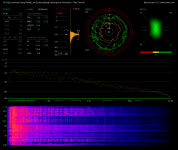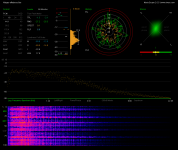Obviously no one here really cares much about speakers, or tries very many... Discussing Met 7's and Magnapans... Might as well be in the 70's...
I tried the top end Thiel's and they drove me out of the room same goes for most horns. I sort of miss the DQ-10 sound of my 80's years, they made some of my favorite LP's sound great even though accuracy was not their strength and they sounded great when the college stations were still all valve.
The work of actually auditioning speakers in my home never appealed to me, if you want to dis John Winey's legacy dissing anyone should be fair game.
Some counter examples, I'm curious and please let's not make this confrontational.
Take out the 56uF cap and re-run the simulation.Sorry to intrude, at this time, about the mains-filter topic (so long ago).
Attached is a AC graph and schematic of the mains-filter as depicted in RN Marsh his US patent 5260862.
There are two questions that I have about the simulation:
1: Why do I not see 20dB of more suppression at 1kHz (maybe I made some wrong assumptions about the mains impedance (or otherwise) and maybe I made some wrong assumption about the load).
2: What about the 56u capacitor (C8), is that not a bit large? and if 56u is needed would this be a suitable capacitor https://nl.mouser.com/datasheet/2/212/F3303_C44E-1104307.pdf
Frans.
I tried the top end Thiel's and they drove me out of the room same goes for most horns. I sort of miss the DQ-10 sound of my 80's years, they made some of my favorite LP's sound great even though accuracy was not their strength and they sounded great when the college stations were still all valve.
The work of actually auditioning speakers in my home never appealed to me, if you want to dis John Winey's legacy dissing anyone should be fair game.
Some counter examples, I'm curious and please let's not make this confrontational.
Confrontational?
My comment highlights how much everyone here cares about the circuits, not the speakers. And I think you mean Jim Winey.
It's just comical to discuss SOTA circuits and then just speakers from 80's.
The latest thing I'm playing with for speakers is some MarkAudio CHP-70's that I scored off of Craigslist, in some nice little DIY boxes. I think MarkAudio drivers might be something this crowd would find interesting because they are extremely articulate. They have vanishing inductance, and it really shows. It couldn't be much easier to put some in a ported box.
I've heard lots of speakers. Most experiences were terrible. But I really don't know for sure when it's the electronics or the speakers - at least not every time.
A short list off the top of my head of some I like thus far (there are a bunch more, don't have time to recollect everything). I think each of these could be appreciated by this crowd if they got a listen:
MarkAudio
Endeavor (under VSA, but I haven't heard any VSA stuff I like yet)
Piega (the have a few really nice ones under $10k, too)
Audio Kinesis
Thrax
Last edited:
My question about Geddes speakers was his use of cheap and poor drivers.
Not sure I agree with you there. Bear in mind that between Earl and his partner you have two lifetimes experience in different aspects of audio. He chose the right drivers for the job and if you notice is happy to defend the choices with good engineering reasons. I believe he was involved in some aspects of the design of at least the woofer.
Ah ah. I tried once to plug my TV sound in my big system: Despite my big screen, there is such a difference between the size of the sonor scene and the one of the screen, that it is impossible.That is what I normally listen to, when listening to fm or tv, which is most of the time.
And it englight all the (numerous) defects of the live recordings that we don't even notice with ordinary speakers.
Here are the results of the spectral analysis just made on two recordings. The first one is a jazz (well, sort of) number "Take five" from "Jazz at the Pawnshop, 30th Anniversary". The middle plot is the cumulative peak spectrum, and the lower one is the spectrogram (time running downwards along the ordinate, frequency is on the abscissa, and the colour stands for spectral energy). The brightest frequency band (i.e. the highest energy) is centered around 130Hz, and it is also seen on another two numbers ad-hoc chosen from the same disc.I have done some analysis of the spectral energy distribution of music. As I remember, except for hip-hop, its centered around 100 Hz. Hip-hop is lower. You can use Audacity for this as I remember. It would be worth the effort to update.
The second example is a classical music recording from a sampler by the German label MDG, who claim not to to use any limiters, compressors, overdubbing, etc. in their recordings. The picture is not as distinctive in this case, with the spectral energy being distributed between 100 and 450Hz.
BTW, the polar diagram shows very fine dynamics of this recording.
Regards,
Braca
Attachments
That tends to reinforce my fuzzy memory. I have trouble with those plots since I'm unfamiliar with them but it seems to show what I saw some years ago.
Related question: efficiency of conversion from electrical power to acoustic power. To generate a given SPL at lower frequencies vs. higher frequencies. Instinctively you don't need as much power at higher frequencies but translating that plus the energy distribution should make optimum driver/amplifier selection pretty straightforward.
Related question: efficiency of conversion from electrical power to acoustic power. To generate a given SPL at lower frequencies vs. higher frequencies. Instinctively you don't need as much power at higher frequencies but translating that plus the energy distribution should make optimum driver/amplifier selection pretty straightforward.
Not sure I agree with you there. Bear in mind that between Earl and his partner you have two lifetimes experience in different aspects of audio. He chose the right drivers for the job and if you notice is happy to defend the choices with good engineering reasons. I believe he was involved in some aspects of the design of at least the woofer.
^
The most expensive drivers are not always the best option. There can be lots of reasons to go with other stuff.
It is some kind of a life's rule.The most expensive drivers are not always the best option. There can be lots of reasons to go with other stuff.
I believe the most expensive products are, in fact, *very rarely* the best option.
I've always found particularly amusing (and useful) authority arguments in tech debatesBear in mind that between Earl and his partner you have two lifetimes experience in different aspects of audio...
The only thing they illuminate is the skill and state of mind of their author
of course.Not sure I agree with you there.
I tried to renew a dialogue with you, I give up.
Last edited:
Well how does one take this?
I mean I know her parents were hoping she would marry a nice Brahmin lad and she ended up with a white guy instead, but not sure any natural laws have been broken.
Your marriage seems counter to nature.
I mean I know her parents were hoping she would marry a nice Brahmin lad and she ended up with a white guy instead, but not sure any natural laws have been broken.
They might not be much fun at parties, but then, I wouldn't expect them to be.I've always found particularly amusing (and useful) authority arguments in tech debates
The only thing they illuminate is the skill and state of mind of their author
.
Confrontational?
My comment highlights how much everyone here cares about the circuits, not the speakers. And I think you mean Jim Winey.
Sorry, I exaggerated unintentionally. If I visit someone and they are still listening to their Magnepans and Sansui receivers I don't immediately cringe and ask them how can you still be listening to this. Frankly it sometimes still sounds good.
I've heard plenty of old stereos with good things going on. Sometimes we should reminisce over them so we can recreate some of their magic... that is what started the original thread we mull about, 20,256 pages later.
Most "gains" that I think people like to rave about are the ability for modern lower distortion drivers to project the RF enhanced sound for spatial information. Well, and sometimes dynamics because a lot of the old stuff wasn't able to do that without being the size of a commercial double fridge.
It would be kinda fun if everyone here had the same speaker, so we could compare different things. The Met 7 being a thing of the past wouldn't be a great option.
Most "gains" that I think people like to rave about are the ability for modern lower distortion drivers to project the RF enhanced sound for spatial information. Well, and sometimes dynamics because a lot of the old stuff wasn't able to do that without being the size of a commercial double fridge.
It would be kinda fun if everyone here had the same speaker, so we could compare different things. The Met 7 being a thing of the past wouldn't be a great option.
Last edited:
- Status
- Not open for further replies.
- Home
- Member Areas
- The Lounge
- John Curl's Blowtorch preamplifier part III

